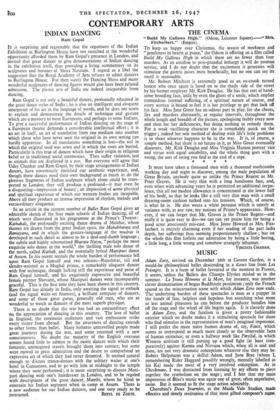CONTEMPORARY ARTS
INDIAN DANCING Ram Gopal
IT is surprising and regrettable that the organisers of the Indian Exhibition at Burlington House have not snatched at the wonderful opportunity afforded them by Ram Gopal's presence in London, and invited that great dancer to give demonstrations of Indian dancing in the exhibition itself, thus providing a living commentary on its sculptures and bronzes of Shiva Nataraja. I regard as a libel the suggestion that the Royal Academy of Arts refuses to admit dancers to Burlington House. For then surely the Dancing Shiva and many wonderful sculptures of dancing figures would also have been refused admission. The plastic arts of India are indeed inseparable from dancing.
Ram Gopal is not only a beautiful dancer, profoundly educated in the great dance styles of India ; he is also an intelligent and eloquent interpreter of his art in the language of words, and he does not scorn to explain and demonstrate the details of technique and gesture which are a mystery to most Europeans, and perhaps to some Indians. To give a successful performance of Indian dancing on the stage of a European theatre demands a considerable intellectual effort ; it is an art in itself, an art of translation from one medium into another which those who have never seen the original in its own setting can hardly appreciate. In all translations something is lost—the soil in which the original seed was sown and in which the roots are buried. Particularly is this true of dances which have their origin in religious belief or in traditional social ceremonies. They suffer violation, just as animals that are displayed in a zoo. But everyone will agree that 'Way Chankar and Ram Gopal, by their stage arrangements of Indian dances, have enormously enriched our aesthetic experience, and, though these dances need their own background as much as do the glorious fragments of Indian sculpture which alone could be trans- ported to London, they still produce a profound—it may even be a disquieting—impression of beauty ; an impression of some physical and spiritual experience of which our western bodies are incapable. Above all they produce an intense impression of rhythm, melody and extraordinary eloquence.
In an article in the current number of Ballet Ram Gopal gives an admirable sketch of the four main schools of Indian dancing, all of which were illustrated in his programme at the Prince's Theatre : Kathakali, the profoundly exciting dance drama of Malabar, whose themes are drawn from the great Indian epics, the Mahabharata and Ranwyana, and in which the gesture-language of the mudras is developed in such detail as almost to be a deaf-and-dumb language ; the subtle and highly schematised Bharata Natya," perhaps the most exquisite solo dance in the world," the thrilling male solo dance of the north, called Kathak, and the essentially lyrical Manipuri dance of Assam. In his recent recitals the whole burden of performance fell upon Ram Gopal himself and two soloists—Rajeshwar, tall and slender-waisted as a Mughal prince, a remarkably eloquent dancer with fine technique, though lacking still the experience and poise of Ram Gopal himself, and his exquisitely expressive and beautiful female partner Shevanti, whose Manipuri dances were incomparably graceful. This is the first time they have been shown in this country. Ram Gopal has already in India, only awaiting the signal to embark (and the signal waits on finances), a brilliant company of dancers, and some of those great gurus, generally old men, who are as wonderful to watch as dancers of ;he most superb physique.
There is no doubt that the war has had an extraordinary effect on the appreciation of dancing in this country. The love of ballet in England, the enormous audiences and vast enthusiasm strike every visitor from abroad. But the awareness of dancing extends to other forms than ballet. Many hitherto untravelled people made great journeys during the war, and some returned with a new consciousness. No doubt the majority of the English overseas armies found little to admire in the exotic dances with which their fantastic, unimagined travels brought them into contact; but some were moved to great admiration and the desire to comprehend an expressive art of which they had never dreamed. It seemed natural enough to discuss trance-dances with the solitary waiter at one's hotel in Cannanore, and to go with him at midnight to the temple where they were performed ; it is more surprising to discuss Malli- puri dancing with one's hairdresser in London, and to be regaled with descriptions of the great dancer, Mambi, whom he hired to entertain his Indian regiment when in camp at Assam. There is a new audience for our Indian dancers, and one very ready to be






























 Previous page
Previous page